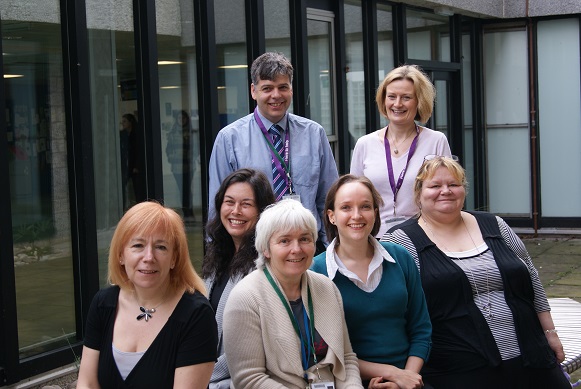The aim of the SCAPE workshop was to show participants how to cope with large data volumes by using automation and preservation tools developed and combined as part of the SCAPE project. During the workshop, we were introduced to Taverna workbench, a workflow engine we we installed with a virtual machine (Linux) in our laptops.
It has taken me a while to sort out my notes from the workshop, facilitated by Rainer Schmidt (Austrian Institute of Technology, AIT), Dave Tarrant (Open Planets Foundation, OPF), Roman Graf (AIT), Matthias Rella (AIT), Sven Schlarb (Austrian National Library, ONB), Carl Wilson (OPF), Peter May (British Library, BL), and Donal Fellows (University of Manchester, UNIMAN), but here it is. The workshop (September 2013) started with a demonstration of scalable data migration processes, for which they used a number of Raspberry Pis as a computer cluster (only as proof of concept).
Rainer Schimdt (AIT)
 Here is a summary of the presentation delivered by Rainer Schmidt (AIT) who explained the SCAPE project framework (FP7 16 organizations from 8 countries). The SCAPE project focuses on planning, managing and preserving digital resources using the concept of scalability. Computer clusters can manage data loads and distribute preservation tasks that cannot be managed in desktop environments. Some automated distributed tasks they have been investigating are extraction of metadata, file format migration, bit checking, quality assurance, etc.
Here is a summary of the presentation delivered by Rainer Schmidt (AIT) who explained the SCAPE project framework (FP7 16 organizations from 8 countries). The SCAPE project focuses on planning, managing and preserving digital resources using the concept of scalability. Computer clusters can manage data loads and distribute preservation tasks that cannot be managed in desktop environments. Some automated distributed tasks they have been investigating are extraction of metadata, file format migration, bit checking, quality assurance, etc.
During the workshop, facilitators showed scenarios created and developed as part of the SCAPE project, which had served as test bed to identify best use of different technologies in the preservation workflow. The hands-on activities started with a quick demonstration of the SCAPE preservation platform and how to execute a SCAPE workflow when running it in the virtual machine.
SCAPE uses clusters of commodity hardware to generate bigger environments to make preservation tasks scalable, to distribute the power required for computing efficiently, and to minimise errors. The systems’ architecture is based on partitions. If failure occurs, it only affects one machine and the tasks that it performs, instead of affecting a bigger group of tasks. The cluster can also be used by a number of people, so only a specific part of the cluster gets affected by the error and thereby only one user.
A disadvantage of distributing tasks in a cluster is that you have to manage the load balancing. If you put loads of data into the system, the system distributes the data among the nodes. Once the the distributed data sets have been processed, the results are sent to nodes where the results are aggregated. You have to use a special framework to deal with the distribution environment. SCAPE uses algorithms to find and query the data. The performance of a single CPU is far too small, so they use parallel computing to bring all the data back together.
The Hadoop framework (open source Apache) allows them to deal with the details of scalable preservation environments. Hadoop is a a distributed file system and execution platform that allows them to map, reduce and distribute data and applications. The biggest advantage of Hadoop is that you can build applications on top, so it is easier to build a robust application (the computation doesn’t break because a node goes down or fails). Hadoop relies on the MapReduce programming model which is widely used for data-intensive computations. Google hosts MapReduce clusters with thousands of nodes used for indexing, ranking, mining web content, and statistical analysis, Java APIs and scripts.
The SCAPE platform brings the open source technologies Hadoop, Taverna and Fedora together. SCAPE is currently using Hadoop version 1.2.0. Taverna which allows you to visualise and and model tasks, make them repeatable, and use repository technology such as Fedora (http://www.fedora-commons.org/). The SCAPE platform incorporates the Taverna workflow management system as a workbench (http://www.taverna.org.uk) and Fedora technology as the core repository environment.
You can write your own applications, but a cost-effective solution is to incorporate preservation tools such as Jhove or METS into the Taverna workflow. Taverna allows you to integrate these tools in the workflow, and supports repository integration (read from and distribute data back into preservation environments such as Fedora). The Taverna workflow (sandpit environment) can be run on the desktop, however for running long workflows you might want to run Taverna on the internet. More information about the SCAPE platform and how Hadoop, Taverna and Fedora are integrated is available at http://www.scape-project.eu/publication/1334/.
Setting up a preservation platform like this also entails a series of challenges. Some of the obstacles you might encounter are mismatches in the parallelisation (difference between desktop and cluster environment). Workflows that work for repositories might not work for web archiving, because they use different distributed environments. To avoid mismatches use a cluster that is centred on specific workflow needs. Keeping the cluster in-house is something of which institutions are wary, while on the other hand they may be reluctant about transferring big datasets over the internet.
Related links:
http://openplanetsfoundation.org/
http://wiki.opf-labs.org/display/SP/Home
http://www.myExperiment.org/


